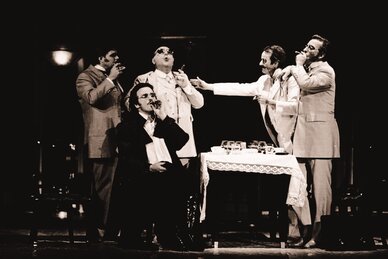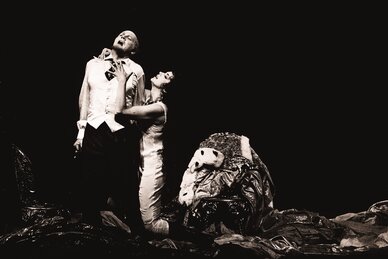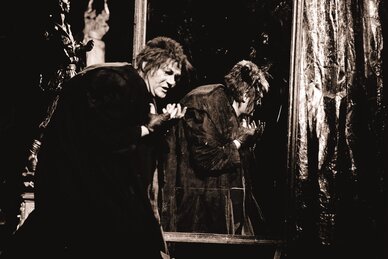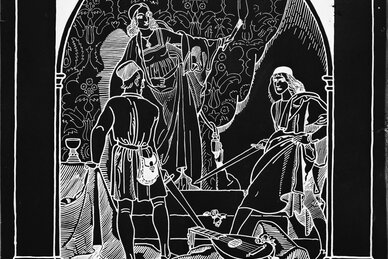
Kleider machen Leute, Vienna Volksoper, 1985, stage photo of Victor Mory with Peter Baillie, Peter Drahosch, Kurt Ruzicka, Wolfgang Schellenberg and Kurt Schreibmayer in the "Smoke Quintet" in Act 1.

„He is at home in opera”
Franz Werfel
Zemlinsky was not the man for course funniness and thigh-slapping comedy but he had a great sense of subtle humour. Gottfried Keller's novella Kleider machen Leute with its mixture of fairy-tale, satire and exaggerated idyll gave him the ideal subject for his musical comedy of the same name, which he composed from 1907 to 1909 (libretto: Leo Feld) and himself conducted the first performance in 1910 at the Volksoper.
Zemlinsky's opera became one of the few successful high quality comedies suitable for repertoire performances in his time. The ambiguity of Keller's play about pretence and reality is reflected in music that is equally indebted to Mozart as well as to Mahler.
With the one-act operas based on Oscar Wilde Eine florentinische Tragödie and Der Zwerg Zemlinsky created two works in Prague which finally established his reputation as one of the most well versed and versatile opera composers of his time. They remain until today his most frequently played stage works.
Eine florentinische Tragödie based on the play of the same name by Oscar Wilde is a chamber work with great psychological intensity. The opera unfolds a single situation, the triangle as often found in Zemlinsky's operas, of a woman caught between two rival men. This constellation inevitably leads to a catastrophe, depicted by Zemlinsky with music which in its erotic richness of sound is reminiscent of Salome by Strauss but functions even more strongly as an independent layer complementing the text by sophisticated nuances.
In Der Zwerg (1919-21) based on Wilde's novella The Birthday of the Infanta the expressionist parlando of the „tragedy” gives way to a more cantabile style and Zemlinsky also again goes back to more traditional forms. Nevertheless, Der Zwerg is ultimately the more modern opera, as heterogynous stylistic layers are cut in an almost film-like technique and transposed over each other. Thus Zemlinsky succeeds in achieving such shattering effects contrasting the cold, calculating world of the princess and the touching fate of the dwarf, who is driven step by step into fatal self-recognition.

Kleider machen Leute, Vienna Volksoper, 1985, stage photo of Victor Mory with Peter Baillie, Peter Drahosch, Kurt Ruzicka, Wolfgang Schellenberg and Kurt Schreibmayer in the "Smoke Quintet" in Act 1.

Eine florentinische Tragödie, Hamburg State Opera 1981, stage photo of Joachim Thode with Kenneth Riegel as Guido Bardi and Elisabeth Steiner as Bianca.

Der Zwerg, London (Royal Opera House Covent Garden) 1985, stage photo of Reg Wilson with Kenneth Riegel as the dwarf.

Franz Wacik: sketch for the title design of a cover for the print edition of the Florentinische Tragödie published by Universal Edition, pen and ink drawing. Wacik was a pupil of Alfred Roller and from 1910 a member of the Vienna Secession. The sketch was not used by the publishers. Zemlinsky found it unusually easy to compose the „tragedy”: „Throughout the entire period (of composition) a certain warmth never left me; everything came to me easily,” he wrote in 1915 to Schoenberg.
